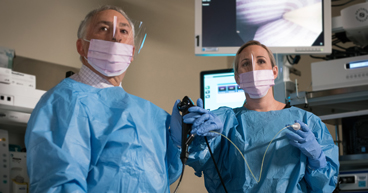


175 Posts

January 23, 2018
Cancer vaccines do exist, but don't expect the impossibleSince the first vaccine for smallpox was developed by English physician Edward Jenner in 1796, vaccines have prevented a variety of devastating maladies and saved millions of lives. The World Health Organization lists 26 available vaccines—for diseases from cholera to yellow fever—and another two dozen are in development for illnesses like malaria and the Zika virus. Not on the list of diseases targeted by current or potential vaccines: cancer. In fact, despite advances in medicine, and in cancer treatment in particular, one unfortunate scientific reality is that a universal vaccine to prevent cancer will likely never be developed.

December 14, 2017
What's the difference? Cutting through the cancer confusionLearning the language of cancer can be difficult. For many patients and caregivers, it’s a jumbled mix of Immuno-this and onco-that.

December 2, 2017
Tracking technology helps cancer doctors find their wayUsing procedures such as navigational bronchoscopy and fiducial marker placement, doctors may be able to reach the furthest recesses of the lungs to help locate and mark tumors that may otherwise be out of reach, except through traditional surgery.

November 16, 2017
Are recent drug approvals a turning point in the lung cancer battle?Many experts believe they're witnessing a turning point in the fight against lung cancer.

November 14, 2017
Using integrative therapies to help manage side effects of cancer treatmentWhen you’ve been diagnosed with cancer, it’s natural to feel as if you have little control over your health, and many patients are willing to try anything to rid their body of cancer.

October 24, 2017
Women are living longer with metastatic breast cancer: Why and what you should knowResearchers discovered that despite the usual prognosis, more women initially diagnosed with metastatic breast cancer have been surviving the disease for longer periods of time, especially women diagnosed at younger ages.

October 3, 2017
Breastfeeding while fighting breast cancer: What you should knowBreastfeeding is a complex but important task for many mothers, because it may be beneficial for the health of both infant and mother.

September 28, 2017
Study finds black men with prostate cancer are less likely to get proper treatmentProstate cancer is not an equal opportunity disease. Black men in the United States have substantially higher prostate cancer incidence and mortality rates than the general population. They are also more likely to be diagnosed with an aggressive form of the disease—which is typically treated with surgery and radiation therapy. Yet, black men are less likely than white patients to seek treatment, and when they do, their doctors are more likely to recommend a watch-and-wait approach over surgery or radiation therapy, according to recent research.

September 19, 2017
Hearing loss: The little-known side effect of some chemotherapy drugsPatients may not associate hearing loss with cancer treatment, but for many, the side effect is all too real. Read more.
Guidelines
The information contained in this blog is not intended nor implied to be a substitute for professional medical advice. Always seek the advice of your physician or other qualified health provider prior to starting any new treatment or with any questions you may have regarding a medical condition. Nothing contained in the blog is intended to be used for medical diagnosis or treatment of any illness, condition or disease.